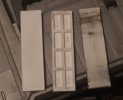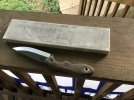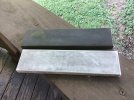-
The BladeForums.com 2024 Traditional Knife is available! Price is $250 ea (shipped within CONUS).
Order here: https://www.bladeforums.com/help/2024-traditional/
You are using an out of date browser. It may not display this or other websites correctly.
You should upgrade or use an alternative browser.
You should upgrade or use an alternative browser.
Ceramic piece vs ceramic stone
- Thread starter Vivekan
- Start date
Mick Boardman
Platinum Member
- Joined
- Jul 15, 2020
- Messages
- 3,086
Right, but that isn't a proper way..Lots of people use the bottom of coffee cups. In theory there must be different “grits”. But I’m not sure.
Let us know how it works out for you.
I was able make piece of ceramic smooth with a 120 grit sanding cloth (ceramic took out all the abrasives). It chews metal pretty fast. But scratch pattern is not like a lower grit stone.
What stone is it??Probably not, most likely ceramic is ceramic.View attachment 1393443View attachment 1393443
- Joined
- Apr 20, 2018
- Messages
- 4,458
Well there are differences in ceramics. Most relevant here would be silica vs. alumina. But you also have to consider grit size and consistency, how brittle will that piece be, Will it clog up or shed grit, etc. I'm not sure if sharpening stones are sintered under pressure or not.
 FortyTwoBlades
have any thoughts?
FortyTwoBlades
have any thoughts?
More info it helps, the guy is ceramic pot/vase maker. He told that his pieces are biscuit fired at 900 degree and then again at 1200 degrees.Well there are differences in ceramics. Most relevant here would be silica vs. alumina. But you also have to consider grit size and consistency, how brittle will that piece be, Will it clog up or shed grit, etc. I'm not sure if sharpening stones are sintered under pressure or not.
FortyTwoBlades have any thoughts?
I have asked him to make the pieces with materials that are as fine as possible/ he can get.
I read somewhere that ceramics pick up the grit that they are flattened or lapped with.
- Joined
- Apr 8, 2020
- Messages
- 2,099
Interesting question.
To the OP's question: unglazed ceramic is different from glazed. Glaze is basically clay with more silica added thus the glassy finish.
Clay is also made up of silica and alumina. In commercially prepared clay, like in an art studio, clay is formulated many different ways. Porcelain is the smoothest and fired to the highest temps, while there are rough finish stonewares used for sculpture that contain refractories, mainly fired clay crushed up, at different sizes to create texture.
There is also industrial ceramics, something I know just a little about, that involves stuff like restaurant use ware, ceramic insulators, etc. This clay is porcelain based but is more like a paste.
I haven't seen the recipe's for that kind of clay, mostly proprietary, so I can't comment on what the make up is. I do remember that it is different from my studio clay and it is fired at a higher temperature (there are three main different studio clays all fired at different temps).
Now, different surfaces, grit if you may.
Clay again contains refractories, tooth we call it, usually sand or fired clay that has been pulverized back to small particles measured by how it passes through a screen. Commonly called a 'mesh size.' For instance, a clay is 60 mesh if it contains refractories that can pass through a 60 hole per inch mesh screen.
The components that clay is made up of, or formulated with, are measured in mesh size also, typically 300 so they are all powders. I know you can order say, silica in meshes smaller than 300 so I think using different sizes of these components creates a different surface feature in the clay. You would think that when you fire it all together it would all melt nicely but that's not the case. You can make smooth or rough clay. Porcelain is the smoothest and typically the purest.
Long to short, clay is not clay and that's how you get different ceramic surfaces.
The problem is lapping the clay to get it flat. I would probably use stoneware as a medium grit and then porcelain as a fine.
To the OP's question: unglazed ceramic is different from glazed. Glaze is basically clay with more silica added thus the glassy finish.
Clay is also made up of silica and alumina. In commercially prepared clay, like in an art studio, clay is formulated many different ways. Porcelain is the smoothest and fired to the highest temps, while there are rough finish stonewares used for sculpture that contain refractories, mainly fired clay crushed up, at different sizes to create texture.
There is also industrial ceramics, something I know just a little about, that involves stuff like restaurant use ware, ceramic insulators, etc. This clay is porcelain based but is more like a paste.
I haven't seen the recipe's for that kind of clay, mostly proprietary, so I can't comment on what the make up is. I do remember that it is different from my studio clay and it is fired at a higher temperature (there are three main different studio clays all fired at different temps).
Now, different surfaces, grit if you may.
Clay again contains refractories, tooth we call it, usually sand or fired clay that has been pulverized back to small particles measured by how it passes through a screen. Commonly called a 'mesh size.' For instance, a clay is 60 mesh if it contains refractories that can pass through a 60 hole per inch mesh screen.
The components that clay is made up of, or formulated with, are measured in mesh size also, typically 300 so they are all powders. I know you can order say, silica in meshes smaller than 300 so I think using different sizes of these components creates a different surface feature in the clay. You would think that when you fire it all together it would all melt nicely but that's not the case. You can make smooth or rough clay. Porcelain is the smoothest and typically the purest.
Long to short, clay is not clay and that's how you get different ceramic surfaces.
The problem is lapping the clay to get it flat. I would probably use stoneware as a medium grit and then porcelain as a fine.
let's doubt that her resulting finish is as smooth, homogeneous, dense, and mean-flat as a commercial ceramic benchstone.asked a ceramic potter to make a
- Joined
- Apr 12, 2009
- Messages
- 13,491
If speaking of 'ceramic' in an all-encompassing, generic sense, it might be said:
" Ceramic is like a box of chocolates - you never know what you're going to get."
'Ceramic' can mean almost anything or nothing in terms of a material's physical properties or capabilities. In the literal sense of the word's origin (in Greek), it means 'pottery'. It's only specific in the sense that it implies some sort of firing/heating is used to produce the final product. But it says essentially nothing about the raw materials used to make it, some of which would be useless as an abrasive for cutting hardened steel.
Some (probably most) types of ceramic pottery are made of clay, containing maybe silica, limestone (less hard than silica) and other natural-earth elements which often won't be hard enough to cleanly cut some hardened steel.
Industrial ceramics like sharpening stones, insulators (electrical & extreme heat-resistant) can be made from aluminum oxide, a.k.a. 'alumina' (3X as hard as silica), silicon carbide (almost 4X as hard as silica) and other materials which are more than hard enough to abrade hardened steel. A big difference with these is that they'll often be nearly pure in their makeup, like 99% alumina, for example. But kitchenware or pottery-grade ceramics (& tiles, etc) will often contain much, much lower concentrations of alumina, if they have any at all. This is part of the reason why it's essentially impossible to assume that all 'ceramic' material will work equally well for purposes of abrading or cutting steel. Most 'ceramics' weren't ever made for that purpose.
" Ceramic is like a box of chocolates - you never know what you're going to get."
'Ceramic' can mean almost anything or nothing in terms of a material's physical properties or capabilities. In the literal sense of the word's origin (in Greek), it means 'pottery'. It's only specific in the sense that it implies some sort of firing/heating is used to produce the final product. But it says essentially nothing about the raw materials used to make it, some of which would be useless as an abrasive for cutting hardened steel.
Some (probably most) types of ceramic pottery are made of clay, containing maybe silica, limestone (less hard than silica) and other natural-earth elements which often won't be hard enough to cleanly cut some hardened steel.
Industrial ceramics like sharpening stones, insulators (electrical & extreme heat-resistant) can be made from aluminum oxide, a.k.a. 'alumina' (3X as hard as silica), silicon carbide (almost 4X as hard as silica) and other materials which are more than hard enough to abrade hardened steel. A big difference with these is that they'll often be nearly pure in their makeup, like 99% alumina, for example. But kitchenware or pottery-grade ceramics (& tiles, etc) will often contain much, much lower concentrations of alumina, if they have any at all. This is part of the reason why it's essentially impossible to assume that all 'ceramic' material will work equally well for purposes of abrading or cutting steel. Most 'ceramics' weren't ever made for that purpose.
Last edited:
Mick Boardman
Platinum Member
- Joined
- Jul 15, 2020
- Messages
- 3,086
- Joined
- Jan 4, 2016
- Messages
- 281
6 years ago, Smith's was selling 6" x 1.5" ceramic stone for a couple of bucks (https://www.knifecenter.com/item/AC167/smiths-fine-ceramic-sharpening-stone-6). It was a subproduct from another industry, but Smith's offered it as a sharpening stone. It was ingenious! It was flat, uniform, fast. The dream has ended - the product was not replenishable. But it shows there is nothing special in ceramic stones such as Spyderco. All knife sharpening community is too small to create demand for a ceramic stone of super high quality that will be super cheap.
- Joined
- Mar 8, 2008
- Messages
- 26,116
Long story short: Sintered ceramic sharpening stones and vitrified sharpening stones are worlds different from pottery ceramics. A potter will be able to produce a stone that does remove some metal, but it will be a far cry from a proper sharpening stone. There are a lot of variables that go into producing a quality sharpening stone, and controlling those variables generally requires kinds of equipment that are outside the realm of ceramic artists.
- Joined
- Aug 13, 2013
- Messages
- 2,072

Thanks for that info about the Smiths ceramic stone.6 years ago, Smith's was selling 6" x 1.5" ceramic stone for a couple of bucks (https://www.knifecenter.com/item/AC167/smiths-fine-ceramic-sharpening-stone-6). It was a subproduct from another industry, but Smith's offered it as a sharpening stone. It was ingenious! It was flat, uniform, fast. The dream has ended - the product was not replenishable. But it shows there is nothing special in ceramic stones such as Spyderco. All knife sharpening community is too small to create demand for a ceramic stone of super high quality that will be super cheap.
I probably picked up 6 or so of them when they were available.
They were actually very flat for the most part and I conditioned a couple of them with SiC grit to make them finer or more aggressive.
Although smaller they cut as well as the Spyderco ceramics.
These things were a smoking deal.
- Joined
- Mar 8, 2008
- Messages
- 26,116
I was SO sad when the resource dried up. They were priced so low it was CRIMINAL.
So how did you manipulate the ceramic's grit.View attachment 1395806
Thanks for that info about the Smiths ceramic stone.
I probably picked up 6 or so of them when they were available.
They were actually very flat for the most part and I conditioned a couple of them with SiC grit to make them finer or more aggressive.
Although smaller they cut as well as the Spyderco ceramics.
These things were a smoking deal.
Did the ceramic pick up the actual grit size of the sillicon carbide stones? How long did they hold the same grit? Help me with the explanation of the process please..
- Joined
- Mar 8, 2008
- Messages
- 26,116
So how did you manipulate the ceramic's grit.
Did the ceramic pick up the actual grit size of the sillicon carbide stones? How long did they hold the same grit? Help me with the explanation of the process please..
Sintered ceramics are fused grit, and have a file-like effect that's dependent on surface texture, so conditioning the surface with different grain sizes will produce different surface textures that will impact how coarse or fine the stone behaves.
Thanks, so if I put 1 micron diamond paste on 2 flat stones and lap them together long enough, they should become a 1 micron stone. Am I right?Sintered ceramics are fused grit, and have a file-like effect that's dependent on surface texture, so conditioning the surface with different grain sizes will produce different surface textures that will impact how coarse or fine the stone behaves.
I'll scribble on the stones with a pencil or wax crayon to make sure they become flat evenly..
The stones are on their way to me. Sad I don't have a usb microscope to post some pics. Any other ideas to take pics of the scratch pattern??
- Joined
- Mar 8, 2008
- Messages
- 26,116
No, not so simple. The micron rating of a sintered stone is meaningless for knife sharpening purposes, and they are usually made of a range of grain sizes to aid in the sintering process. Grit rating ≠ surface finish produced in use. The grain size of the loose grit used for conditioning the face of a sintered stone doesn't produce a finish equivalent to that of the grit. Generally it will be MUCH finer.


